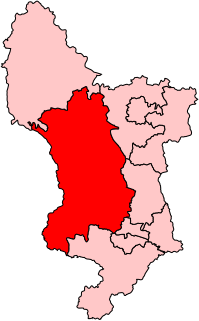
West Derbyshire was a county constituency represented in the House of Commons of the Parliament of the United Kingdom. From 1885 until it was replaced by the Derbyshire Dales constituency in the 2010 General Election, it elected one Member of Parliament (MP) by the first past the post voting system. It was a safe Conservative seat for most of its existence.
Glasgow Hillhead was a parliamentary constituency represented in the House of Commons of the Parliament of the United Kingdom from 1918 until 1997. It elected one Member of Parliament (MP) using the first-past-the-post voting system.
Abertillery was a county constituency centred on the town of Abertillery in Monmouthshire. It returned one Member of Parliament (MP) to the House of Commons of the Parliament of the United Kingdom, elected by the first past the post system of election. From 1950 up to 1970, it was the safest Labour seat in the United Kingdom.
Dulwich was a borough constituency in the Dulwich area of South London, which returned one Member of Parliament to the House of Commons of the Parliament of the United Kingdom.
Westminster Abbey was a constituency in the Parliament of the United Kingdom. It returned one Member of Parliament (MP) to the House of Commons by the first past the post system of election.
Newcastle upon Tyne West was a parliamentary constituency in the city of Newcastle upon Tyne which returned one Member of Parliament (MP) to the House of Commons of the Parliament of the United Kingdom.

Hornsey was a constituency that returned one Member of Parliament (MP) to the House of Commons of the UK Parliament, 1885 — 1983. It was then largely replaced by Hornsey & Wood Green. Its voters using the first-past-the-post system elected the Conservative Party candidate at each election. Its closest result was a 1.29% majority at the 1966 election which saw the start of the Second Wilson Ministry. From 1945 onwards the runners-up in the seat were the Labour Party candidates.
Kingston or Kingston-upon-Thames was a parliamentary constituency which covered the emerging southwest, outer London suburb of Kingston upon Thames and which existed between 1885 and 1997 and returned one Member of Parliament (MP) to the House of Commons of the UK Parliament. The Conservative candidate won each election during its 112-year existence.
Oldham was a parliamentary constituency centred on the town of Oldham, England. It returned two Members of Parliament (MPs) to the House of Commons of the Parliament of the United Kingdom. The constituency was created by the Great Reform Act of 1832 and was abolished for the 1950 general election when it was split into the Oldham East and Oldham West constituencies.
Rothwell was a parliamentary constituency centred on the Rothwell area of West Yorkshire. It returned one Member of Parliament (MP) to the House of Commons of the Parliament of the United Kingdom, elected by the first past the post system.
The Darwen by-election, 1943 was a by-election held on 15 December 1943 for the British House of Commons constituency of Darwen in Lancashire.
The Newport by-election, 1945 was a parliamentary by-election held on 17 May 1945 for the British House of Commons constituency of Newport in Monmouthshire. It was the last by-election of the 1935-1945 Parliament.
The East Norfolk by-election, 1939 was a parliamentary by-election held on 26 January 1939 for the British House of Commons constituency of East Norfolk.
The North Cornwall by-election, 1939 was a parliamentary by-election held on 13 July 1939 for the British House of Commons constituency of North Cornwall.

The Chelmsford by-election, 1945 was a parliamentary by-election for the British House of Commons constituency of Chelmsford, Essex on 26 April 1945.
The Batley and Morley by-election, 1939 was a parliamentary by-election held in the United Kingdom on 9 March 1939 for the House of Commons constituency of Batley and Morley in the West Riding of Yorkshire.
The Brecon and Radnorshire by-election, 1939, was a parliamentary by-election held on 1 August 1939 for the British House of Commons constituency of Brecon and Radnorshire, in South Wales.
The Grantham by-election, 1942 was a parliamentary by-election for the British House of Commons constituency of Grantham on 25 March 1942.
The Cambridge University by-election, 1940 was a parliamentary by-election for the British House of Commons constituency of Cambridge University on 23 February 1940. Cambridge University was a two-member constituency.
The Skipton by-election, 1944 was a parliamentary by-election for the British House of Commons constituency of Skipton, Yorkshire held on 7 January 1944.




